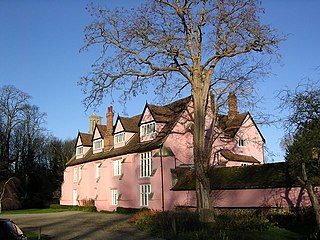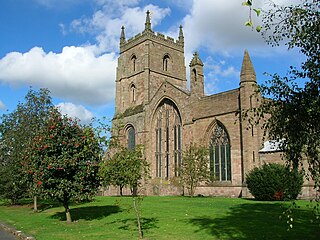This article needs additional citations for verification .(May 2022) |
Swaffham Bulbeck Priory was a priory in Cambridgeshire, England. [1]
This article needs additional citations for verification .(May 2022) |
Swaffham Bulbeck Priory was a priory in Cambridgeshire, England. [1]
Luffield Abbey is a place in the very north of Buckinghamshire, England. It is on the border with Northamptonshire, close to Biddlesden and Silverstone.
Sopwell Priory was built c. 1140 in Hertfordshire, England by the Benedictine abbot of St Albans Abbey, Geoffrey de Gorham. It was founded as the Priory of St Mary of Sopwell and was a cell of St Albans Abbey.

Clare Priory is a religious house in England, originally established in 1248 as the first house of the Augustinian Friars in England. It is situated on the banks of the River Stour, a short distance away from the medieval village of Clare, Suffolk. the friary was suppressed in 1538 and the property passed through many hands until it was again purchased by the Augustinian friars in 1953. Today the Priory offers modern retreat facilities for guests.

Isleham Priory Church, located in Isleham, Cambridgeshire, is a Norman church, built in ca 1090. Despite being converted into a barn, it remains in a largely unaltered state.

Chatteris Abbey in Chatteris in the Isle of Ely, Cambridgeshire was founded as a monastery for Benedictine nuns in 1016 by Ednoth, Bishop of Dorchester. Before 1310 much of the monastery was destroyed by fire. By the middle of the 14th century, some of the local families appear to have been using the nave of the monastic church as their parochial church.

The Priory Church is an Anglican parish church in Leominster, Herefordshire, England, dedicated to Saint Peter and Saint Paul. The building was constructed for a Benedictine Priory in about the 13th century, although there had been an Anglo-Saxon monastery in Leominster, possibly on the same site. In 1539 the east end of the church was destroyed along with most of the monastic buildings, but the main body of the church was preserved.

Snelshall Priory was a Benedictine priory in Milton Keynes, Buckinghamshire in the United Kingdom, built around 1200. The priory was founded after Sybil d'Aungerville granted land at Tattenhoe to Lavendon Abbey, a Premonstratensian monastery of 'White canons' who most likely started a cell at Snelshall. This did not thrive and was abandoned about 1207. About 1219, the founder's son brought in Benedictine monks, increased the endowment and the new monastery began again. However Snelshall Priory paid 1 mark a year to Lavendon until 1232, at which point the Bishop of Lincoln decided that Snelshall owned its own lands and chapel. The priory accumulated various land through gifts, but even with all these grants, in 1321 when Henry Burghersh visited, it was so poor that "the monks scarcely had the necessities of life and had to beg even for these".

Leominster abbey was an Anglo-Saxon monastery established at Leominster in the county of Hereford, England. The name of the town refers to its minster, a settlement of clergy living a communal life.

Chatteris railway station was a station in Chatteris, Cambridgeshire on the line between St Ives and March. For much of its history it was run by the Great Eastern Railway. It closed to passengers on 6 March 1967 in the wake of the Beeching Report. The station was demolished in the early 1970s and the station site/ trackbed used for the new alignment of the A141 road.

St Ives Priory was a priory in Cambridgeshire, England. It was established in 1017 by monks from Ramsey Abbey.
Swavesey Priory was a medieval monastic house in the village of Swavesey, Cambridgeshire, England. A church existed in Swavesey at the time of the Norman Conquest, when Alan, Count of Richmond, granted it to the Benedictine Abbey of St Sergius and St Bacchus in Angers, France. The Abbey founded an alien priory in Swavesey by 1086. It ceased to function in 1539, during the dissolution of the monasteries. The site is now a scheduled ancient monument.
Boston Priory was a priory in Boston, Lincolnshire, England.

Deeping St James Priory was a priory in Deeping St James, Lincolnshire, England. In 1139 Baldwin Fitz Gilbert established the Benedictine Priory of Saint James at Deeping as a cell of Thorney Abbey. The cell was dissolved at the surrender of Thorney in 1539. The priory church remains as the Church of England parish church of Deeping St James and is a Grade I listed building.
Freiston Priory was a Benedictine cell of Crowland Abbey founded in 1114, and became a priory soon afterwards. It was Dissolved in 1539 and was located in Freiston, Lincolnshire, England.
Long Bennington Priory was a priory in Lincolnshire, England.

Pentney Priory was an Augustinian priory at Pentney in the district of King's Lynn and West Norfolk, Norfolk, England. The ruins of the priory, mostly comprising the flint-built gatehouse, are Grade I listed.

Fineshade Priory was a priory of Augustinian Canons Regular in Northamptonshire, England. The remains of the site are about 5 miles (8.0 km) north-east of Corby along the A43 road.
Eye Priory was a Benedictine Priory dedicated to St Peter in the town of Eye in the English county of Suffolk. It was founded by Robert Malet c. 1080 and originally an Alien Priory dependent on Bernay Abbey in Normandy. It became independent in 1385 by charter of Richard II when it could support only 3-4 monks. It was finally dissolved in 1537 as part of the Dissolution of the Monasteries, with the lands being given to Charles Brandon, 1st Duke of Suffolk.
Snape Priory was a priory in Suffolk, England. It was founded as a cell of the Benedictine St John's Abbey, Colchester in Essex.